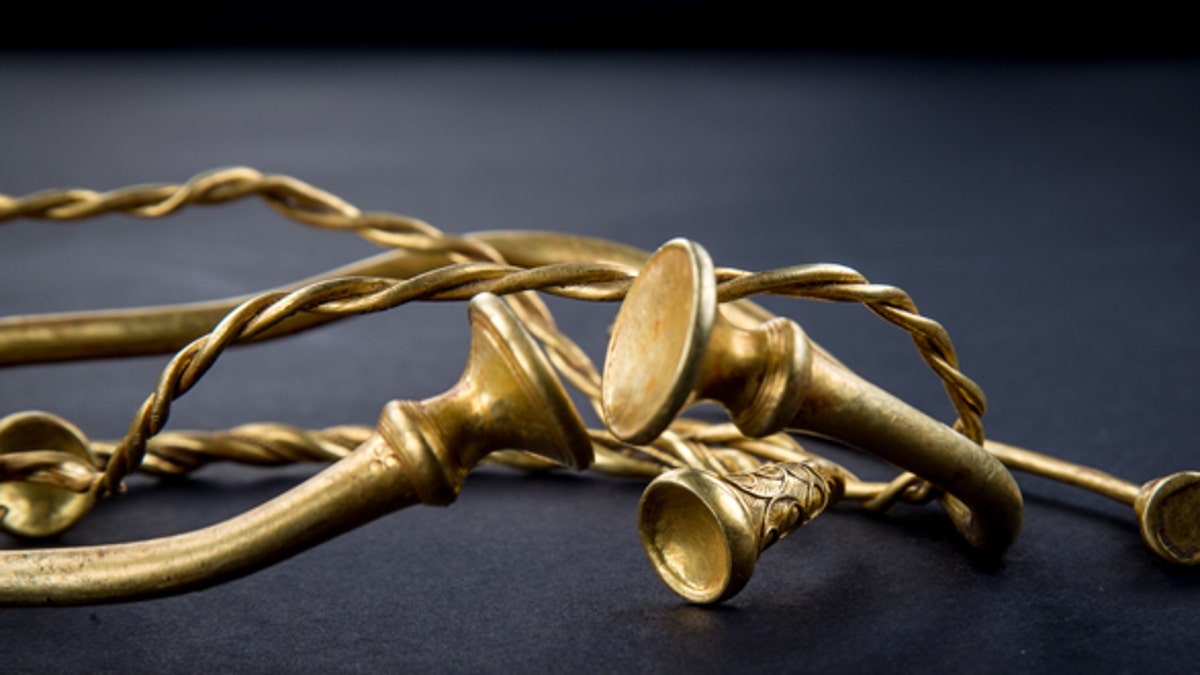
The Leek Frith Torcs (Staffordshire County Council).
An incredible haul of ancient gold jewelry has been unearthed the U.K. by two treasure hunters using metal detectors.
Detectorists Mark Hambleton and Joe Kania found the four torcs, a form of ancient necklace or bracelet, on farmland in Staffordshire in December. The finds, which were handed over to the U.K. government-funded Portable Antiquities Scheme, were announced Tuesday.
Dubbed the Leek Frith Torcs, the finds may date as far back as 400 B.C. and could be the earliest examples of Iron Age gold ever discovered in Britain, experts say. The torcs, which include three neck torcs and one bracelet, are thought to be from continental Europe, possibly Germany or France.
HUGE 3,000-YEAR-OLD GOLD 'BELT' UNEARTHED IN THE UK
Dr. Julia Farley, curator of the British & European Iron Age Collections at the British Museum, assessed the items. “This unique find is of international importance. It dates to around 400–250 BC, and is probably the earliest Iron Age gold work ever discovered in Britain,” she said, in a statement. “The torcs were probably worn by wealthy and powerful women, perhaps people from the continent who had married into the local community. Piecing together how these objects came to be carefully buried in a Staffordshire field will give us an invaluable insight into life in Iron Age Britain.”

The Leek Frith Torcs (Staffordshire County Council).
The site in the Staffordshire Moorlands area was investigated by archaeologists from Stoke-On-Trent City Council, who described the find as “complete” with no evidence of other pieces.
The BBC reports that the pieces will be on display at the Potteries Museum and Art Gallery in Stoke for the next three weeks.
ALTAR OF VIKING SAINT-KING DISCOVERED IN NORWAY
“This amazing find of gold torcs in the North of the county is quite simply magical and we look forward to sharing the secrets and story they hold in the years to come,” said Staffordshire County Council Leader Philip Atkins in the statement.
An inquest Tuesday declared that the find was treasure, the BBC reports, with the artifacts deemed the property of the Crown, or British state. The UK Government’s Treasure Valuation Committee will offer a value to the metal detectorists that found the haul, the landowner where the discovery was made, and any museum that wants to acquire the torcs, according to the BBC.
Once the parties agree on the valuation, the museum would have to raise the money to pay for the artifacts. The finders say they will share the proceeds with the landowner.
FARMER'S FIELD YIELDS HOARD OF ENGLISH CIVIL WAR COINS
This is the latest stunning ancient jewelry find in the U.K. In 2015 a huge 3,000-year-old gold belt, described as one of the largest ever discovered, was unearthed in Cambridgeshire.
